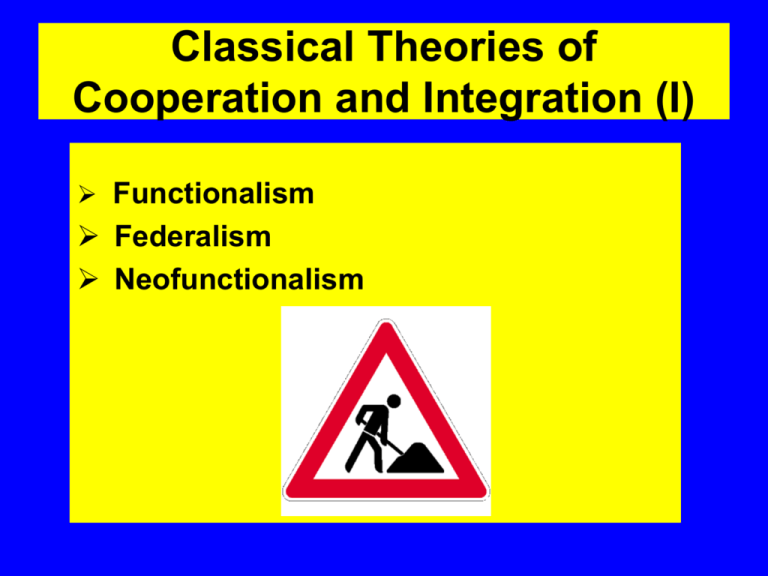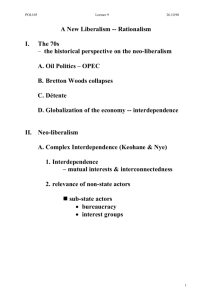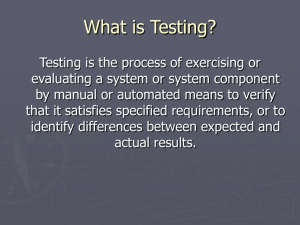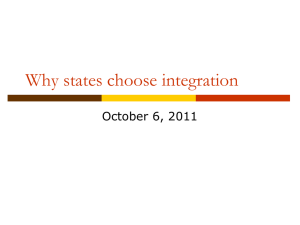Classical Theories of Cooperation and Integration (I)
advertisement

Classical Theories of Cooperation and Integration (I) Functionalism Federalism Neofunctionalism Creation of welfare by market integration and management of international economic interdependencies The two logics of the integration process Resultant direction of the integration process Peace by cooperation and common security production Creation of welfare by market integration and management of international economic interdependencies The two logics of the integration process 2 Resultant direction of the integration process Functional economic, societal, and political necessities caused by the progress of the forces of production and resultant changes in the societal superstructure Necessity of integration to avoid further conflicts in (Western) Europe by embedding (and thereby controlling) the German industrial and military potential in a supranational governance structure supported by overcoming traditional German – French enmities Peace by cooperation and common security production Creation of welfare by market integration and management of international economic interdependencies Functionalism Neofunctionalism Interdependence & Regime Theories The two logics of the integration process 3 Resultant direction of the integration process Multilevel Governance Approaches Federalism, InterGovernmentalism, Neoliberal Institutionalism Peace by cooperation and common security production TRADITIONAL APPROACHES TO THE EUROPEAN INTEGRATION PROCESS OR The Dialectic of Supranationalism and Intergovernmentalism National states transfer certain National states cooperate on the rights their (inter-) governmental level without sovereignty to a supra-national formally questioning parts of their authority sovereignty or parts constituted of as an independent international actor by international treaty or limiting the execution of their sovereign rights DIFFERENT PERSPECTIVES ON THE INTEGRATION PROCESS Functionalism; Neofunctionalism Federalism; Intergovernmentalism Moves towards closer integration gradually/incrementally advanced by a multitude of political and economic actors on the basis of individual/organisational learning processes leading to (integrationfriendly) positive changes of political and socioeconomic preferences Integration as a result of political negotiation processes consciously entered into by national actors on the basis of previously defined political and socioeconomic preferences Process of collective decision-making in a network of actors Process of multilateral decisionmaking in an administration union („Zweckverband“) of states Development of shared solutions to shared policy problems (Helen Wallace) Theories of international Integration and Cooperation political solutions (moved by political will/ expressed decisions) general aim: institutionalization of the constitutive conditions necessary for achieving a stable peace structure functional solutions (moved by inherent necessities) problem: creation of a security community in (Western) Europe to prevent the outbreak of a new war; supranational regulation of economic issue areas as precondition for the (political) peace-stabilizing community-building process Federalism Functionalism Neofunctionalism problem: actors’ reaction towards emerging political, economic and social interdependencies in the context of the internationalization/globalization of socioeconomic relations within the spheres of production, distribution, services, communications Theory of Hegemonic Stability Interdependence Theory Problem: guaranteeing „governance without Complex Interdependence Theory government“ in the societal world Intergovernmentalism Theory of Fusion Regime Theory Neoliberal Institutionalism ideal solution: development of a supranational constitutional authority including democratically legitimated and controlled monopoly of power at the interface of domestic democratic politics and internationally regulated cooperation stabilized through compromise and adjustment within legal procedures 8 9 Theories and Strategies of European Integration Functionalism and Neofunctionalism or form follows function 10 Forefathers… David MITRANY: “One might say indeed that the true task of peaceful change is to remove the need and the wish for changes of frontiers.“ (Mitrany, D. (1943). A Working Peace System, Chicago) 11 Functionalism • Emergence and growth of international organizations is a consequence of the autonomy of industrial societies, characterized by the progress of the forces of production , and the internationalization of socio-economic problem complexes, which can only be resolved by means of inter-state or supra-state cooperation. Thus, international organizations can be compared to administrative/ executive unions or a “Zweckverband”, active in primarily technical non-political issueareas. They simultaneously relieve states of some of their tasks and deprive them of some of their power without incorporating them in a superior political entity. The internationalization of problem complexes is governed by the logic of functional necessity; functional necessities thus produce on the international level mechanisms of collective problem resolution and the concomitant adequate organisational forms. • Distinctive feature: Economic and social problems produce their own (framework of) respective solutions; international cooperation is legitimized by the usefulness and efficiency of concrete, issue-specific (technical) cooperation and its outcomes. • Catchword: Form follows function. 12 Assumptions I Human nature: • rational and cooperative behaviour State: • need-centric rather than state-centric perspective • human needs and public welfare rather than power politics International system: • transnational problem solving • interdependence • globalisation 13 Assumptions II International agencies: • render war irrational / impossible through collective transnational problem solving and mutual dependence • more conducive to the maintenance of international peace and stability • transcend any anarchical structures in world politics 14 Neofunctionalism • As socioeconomic problems of highly industrialized societies, due to their border-transgressing causes and consequences, cannot be resolved any longer by individual state action but require comprehensive solutions that encompass all actors, the integration of several actors arises out of purely functional necessities. • At the beginning of the integration process actors formally agree (contractual arrangements) to solve problems within technical, functional, non-political and small sector-based issue areas (low politics) in a technocratic and non-ideological way. As cooperative management and problem solving approaches prove to be successful, they expand to other related functional task-areas and will finally spill over into genuinely political (high politics) issue areas, where they also initiate a gradual process of integration (logic of integration by sectors: supranational communitisation of state functions in a succession of neighbouring policy areas produces quasi-automatic integration by means of spill-over effects). • Distinctive feature: Political actors play a decisive role in the process of combining the requirements of problem solutions and adequate institutional provisions; they transfer their loyalties and benefit expectations in an ever-intensifying manner to the supranational level,15 thereby legitimizing and stimulating the integration process. (Neo-) Functionalism Assumptions rejection of the state and power concept human beings are essentially cooperative and act rationally same (transnational) problems interest in joint problem solving Strategies • functional governance • self-perpetuating process with • open finalité • cultivated spill over Logics • form follows function • spill-over • “Sachlogik” • from single market to political union • problem-solving by emphasising expertise • epistemic communities • transfer of loyalty and sovereignty Institutions • technocracy • European Commission as engine of integration, produces consensus • technocratic knowledge as source of legitimacy (ECB) • close interaction between administration and interestgroups 16 The logic of transborder cooperation 17 Theories and Strategies of European Integration: Federalism & (Neo-)Federalism or function follows form 18 Forefathers… Immanuel KANT: “…But peace can neither be inaugurated nor secured without a general agreement between the nations; thus a particular kind of league, which we might call a pacific federation (foedus pacificaum), is required.” (Kant, I. (1795). Perpetual Peace: A Philosophical Sketch) Alexander HAMILTON: “To look for a continuation of harmony between a number of independent unconnected sovereignties situated in the same neighbourhood, would be to disregard the uniform course of human events and to set at defiance the accumulated experience of ages.” (Federalist Papers, Federalist n° 6, Concerning the Dangers from Dissensions between States) 19 … and successors Winston CHURCHILL: “We must build a kind of United States of Europe […] freely joined together for mutual convenience in a federal system. […] We must re-create the European Family in a regional structure called, it may be, the United States of Europe. […]” Therefore I say to you: let Europe arise! (Churchill, W. Speech to the academic Youth, Zurich, 19.9.1946) Altiero SPINELLI: “The question which must be resolved first […] is the definitive abolition of the division of Europe into national, sovereign States.“ “All problems … would find easy solutions in the European Federation.“ “MOVEMENT FOR A FREE AND UNITED EUROPE“ (Spinelli, A. (1944). For a Free and United Europe. A draft manifesto (Ventotene Manifesto)) 20 Federalism • The integration of several national actors takes place as a consequence of willful political decisions taken by politicians and nations and based on common political and socioeconomic norms and objectives. At the beginning of the integration process a common constitution for the newly integrated actor will be formulated. This actor usually takes the form of a federal state with horizontal and vertical separation of powers; the formerly autonomous units give up their claim to sovereignty and submit to a common will. • Distinctive feature: Solutions of economic and social problems fill a previously established (institutional) framework; pooling of sovereignty of individual actors. • Catchword: Function follows form. 21 (Neo-) Federalism Assumptions • power-seeking people and states; • security dilemma • anarchy as central problem • discredited nation-state • one European people • division of authority between levels Strategies • first deepening, then widening • avantgarde, CoreEurope, “Fédération d’Etatnations”, pioneer Europe 22 Pious hopes… John PINDER: “[...] either the federal elements in the institutions will be strengthened until the Union becomes an effective democratic polity, or it will fail to attract enough support from the citizens to enable it to flourish, and perhaps even to survive.” (Pinder, J. (2001). The European Union: A very short Introduction, Oxford) 23 Functionalism - Federalism - Neofunctionalism Functionalism rapprochement of sovereign states is best achieved by progressive cooperation within specific issue areas because of increasing socio-economic interdepen-dence, problems within these issue-areas are more effectively dealt with in an international rather than national context driving force: functional necessities construction of an increasingly intensifying network of common technical (unpolitical) activities and administrative tasks Federalism I.: II.: The traditional sovereign nation state causes the negative developments of the international system ( security dilemma) successful peacemaking/ peace stabilisation presupposes the limitation of the sovereign nation states’ exclusive title to power the adequate device to fulfill this requirement is the formation of a (European) Federal State by a conscious political decision of politicians/ peoples involved For tightening of interstate relations gradually includes genuinely political problem/ issue areas (reason: cooperation in some specific issue areas induces learning processes that enhance cooperation within other/ related issue areas) complex network of overlapping, functionally differentiated international and transnational organizations (cobweb-model of international relations) overarches, erodes, undercuts classical functions and spheres of competence of the state final result: declining significance of national borders, demise/ death of nation states the execution of specific tasks in their own interest states may submit partially or completely to a common central authority (pooling of (partial) sovereignties) The instrument of integration is a supranational constitution in the regulatory framework of which political (and to a lesser degree socio-economic) integration between states takes place driving force: political will/ political decisions The partial or complete transfer of sovereignty to the central authority secures the outcome of the integration process; conflicts can be regulated within the framework of commonly accepted and hard to alter constitutional norms common characteristics: incremental nature of the integration process Spillover as driving force final aim: supersession of the nation state (yet disagreement on by what sort of institution it will be replaced) Neofunctionalism Functionalism common characteristics: incremental nature of the integration process Spillover as driving force final aim: supersession of the nation state (yet disagreement on by what sort of institution it will be replaced) Neofunctionalism stresses the role/importance of supranational institutions for the progress of the integration process a once started integration process is followed by additional/ further integrative measures (spillovereffect) driving force: functional necessities inclusion of further policy areas hitherto not integrated transition from economic to political integration driving force: coalition of national political and socio- economic elites with supra-national actors; their aim: advancement of common interests final result: supranational federal political unit explanatory problem: observable coexistence of national, intergovernmental, federal and supranational elements as well as the coexistence of functional necessities and voluntary political decisions within the actual process of European integration Recommended reading • Michael O‘Neill (1996): The Politics of European Integration. A Reader. London: Routledge. • Ben Rosamond (2000): Theories of European Integration. Basingstoke: Macmillan. • Antje Wiener/Thomas Diez (eds.) (2005): European Integration Theory. Repr. Oxford: OUP. • Hans-Jürgen Bieling/ Marika Lerch (eds.) (2005): Theorien der europäischen Integration. Wiesbaden: VS Verlag. • Anne Faber (2005): Europäische Integration und politikwissenschaftliche Theoriebildung. Neofunktionalismus und Intergouvernementalismus in der Analyse. Wiesbaden: VS Verlag. 26 Variants of Integration Theory 27 Variants of Integration Theory: A quick overview Federalism The integration of several national actors takes place as a consequence of wilful political decisions taken by politicians and nations and based on common political and socio-economic norms and objectives. At the beginning of the integration process a common constitution for the newly integrated actor will be formulated. This actor usually takes the form of a federal state with horizontal and vertical separation of powers; the formerly autonomous units give up their claim to sovereignty and submit to a common will. Distinctive feature: Solutions of economic and social problems fill a previously established (institutional) framework; pooling of sovereignty of individual actors. Catchword: Function follows form Functionalism Emergence and growth of international organization is a consequence of the autonomy of industrial societies, characterized by the progress of the forces of production , and the internationalization of socio-economic problem complexes, which can only be resolved by means of inter-state or suprastate cooperation. Thus, international organizations can be compared to administrative/ executive unions, active in primarily technical political issue-areas. They simultaneously relieve states of some of their tasks and deprive them of some of their power without incorporating them in a superior political entity. The internationalization of problem complexes is governed by the logic of functional necessity; functional necessities thus produce on the international level mechanisms of collective problem resolution and the concomitant adequate organisational forms. Distinctive feature: Economic and social problems produce their own respective (framework of) solutions; international cooperation is legitimized by the usefulness and efficiency of concrete, issue-specific (technical) cooperation and its outcomes. Catchword: Form follows function. Neofunctionalism As socioeconomic problems of highly industrialized societies, due to their border-transgressing causes and consequences, cannot be resolved any longer by individual state action but require comprehensive solutions that encompass all actors, the integration of several actors arises out of purely functional necessities. At the beginning of the integration process actors formally agree (contractual arrangements) to solve problems within technical, functional, non-political and small sector-based issue areas (low politics) in a technocratic and non-ideological way. As cooperative management and problem solving approaches prove to be successful, they expand to other related functional task-areas and will finally spill over into genuinely political (high politics) issue areas, where they also inititate a gradual process of integration (logic of integration by sectors: supranational communitization of state functions in a succession of neighbouring policy areas produces quasi-automatic integration by means of spillover effects) Distinctive feature: Political actors play a decisive role in the process of combining the requirements of problem solutions and adequate institutional provisions; they transfer their loyalties and benefit expectations in an ever-intensifying manner to the supranational level, thereby legitimizing and stimulating the integration process. Hegemonic Stability Theory The free-rider problem inherent in the management of the global economy requires a hegemonic power capable of providing collective/ public goods. Motivated by its own (enlightened) selfinterest, the most powerful state existing in an international system in a given period in time creates specific international regimes in order to defend / pursue its self-interest throughout the system. Though set up by a hegemonic power, these regimes occasionally continue to exist even after the decline of the hegemon, because nation states assumed to be rational, egoistic utilitymaximisers develop an interest in the regime’s persistence. Interdependence Theory Within the context of growing interdependence and integration, the modernization/ industrialization/ internationalization of the exchange of commodities and services does increase the sensitivity of actors to developments within other actors. Mutual interdependence and changes in the interdependence structure entail - often unequally distributed - costs and benefits. Whereas sensitivity describes the costs of the actor’s reaction towards changes within the system, the term vulnerability denotes the costliness of a substantial change within the system structure. => cobweb model of international politics (John Burton) Complex Interdependence International relations are characterized by a complex conglomerate system of inter- and transnational interrelationsships between a wide range of governmental and nongovernmental national as well as international actors. The traditionally given hierarchy of security issues over welfare/ socio-economic issues is replaced by variable sets of themes and preferences depending on the specific policy area. As national actors are integrated into a complex network of mutual interdependencies, the importance of the resort to force/organized violence as an instrument of foreign/ state policy is likely to be diminished. Intergovernmentalism The horizontal coordination of government policies and the vertical coordination of policies of governments and supranational institutions characterizes e.g. the EU as a co-operative communal project of nation states. Within a common institutional framework that improves the conditions for cooperative action, nation states are striving •for the reduction of transaction costs; •for the achievement of gains/ avoidance of losses from cooperation; •for the increase of the efficiency of intergovernmental negotiation and bargaining processes; •for the effectivisation of governmental instruments and means of action. Within a framework of a complex multi-layered institutional structure horizontal decision-making networks are dominating over hierarchically organized decision-making structures. They are, however, frequently characterized by multi-level policy interlocking (or even interblocking) and by possible suboptimal outcomes of problem solutions („Politikverflechtungsfalle“ (interlocking policy trap): multi-level decision networks generate inadequate decisions/ solutions, while simultaneously being unable to change the institutional conditions underlying their decisional logic). Instead of being conceived of as a goal, the transfer of sovereign power is turned into a calculated instrument that serves a specific purpose: to further cooperation between states within a protected institutional framework, thus removing it from the realm of international anarchy and its hostile effects on cooperative endeavours. Regime Theory Factual and empirical problems lead to the formation of informal networks of agreements, principles, rules, norms and decision-making procedures that enhance the institutionalization of the political management of conflicts and interdependence problems and mitigate conflicts through means of (legal) regulation and control. Thus, they contribute to the civilization of the relations among the actors and stabilize the predictability of the actors’ decisions/ actions. Regimes support, supplement, undercut or overarch the spheres of competence of the traditional society of states and integrate the cooperation of actors into a complex multi-level system of political or socio-economic decisionmaking processes that do account for the actors’ regulatory interests in each particular issue area. Within that context, the EU could be conceived of as a relatively effective international regime constructed for the management of problems of economic interdependence by means of negotiated political coordination processes. Neoliberal Institutionalism Drawing on Interdependence Theory, Neoliberal Institutionalism identifies tendencies towards the institutionalization and normative regulation of conflict and cooperation. While accepting the neorealistic image of the international system as regulated anarchy in which a central authority is absent, it rejects the idea that the system structure does exclusively determine the politics/ behaviour of states. It rather insists on the importance of institutions, regimes, IGOs/INGOs within the structure of the international system and their influence on the behaviour of various actors. Credo: „Institutions matter“. System and structure of international relations constrain the behaviour of states, but states, in turn, can exert influence on those structures by building up institutions. Cooperative structures are able to persist in a multipolar system without a hegemonic power because they enhance the actors’ knowledge and information about other actors’ intentions; their demise or break-down would induce costs on those no longer willing to cooperate; they foster linkages across issue/ problem areas by negotiating package solutions, facilitate arrangements and reduce the transaction costs for the negotiation of international agreements; they affect the actor’s definition of its self-interest and fundamental preferences. The emergence/ extension of cooperative networks does neither reflect a harmony of interests nor economic interdependence, but rather indicates the actors’ national self-interest in easing processes of interstate negotiation and collaborative action.






